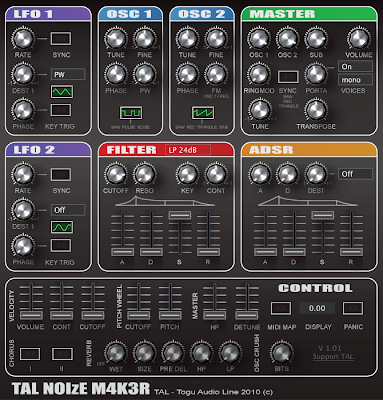
I've often said that owning a synthesizer and never learning how to program your own sounds is a bit like owning a Ferrari and never driving it over 35 miles an hour. Sure, it'll probably still get you the chicks, but you're missing out on half the fun.
Still, I understand it's not for everyone. And sometimes, a particular preset just happens to fit the arrangement perfectly, save for a few characteristics you'd like to change. So how do you make those changes without needing to know how to program a sound from scratch? Fortunately, most synths share a common range of parameters that make this pretty easy. Keep in mind that many synths use differing terminology to describe the same things, but with a little noodling around, you'll figure it out. Here are some guidelines:
CHANGING THE OVERALL TIMBRE
To change the overall timbre of the sound most easily, try changing the WAVEFORM in the synth's OSCILLATOR section. This is where the 'raw material' of your sound starts, so it has quite a big influence on what the end result sounds like.
MAKE THE SOUND BRIGHTER
Assuming the synth uses a lowpass filter (this is the most common type), you can get this result by increasing the CUTOFF (sometimes called FREQ) in the FILTER section. Also try increasing the FILTER'S ENV AMOUNT to exaggerate, for example, the pluck in a plucked type sound.
MAKE THE SOUND DARKER.
As above, try lowering the CUTOFF value of your FILTER, as well as decreasing the ENV AMOUNT on the FILTER.
MAKE THE SOUND REACT FASTER AND SNAPPIER
If you have a relatively slow sound, like strings, you can give them a more immediate sound by decreasing the ATTACK value in the AMP ENVELOPE. Try also manipulating the ATTACK in the FILTER ENVELOPE if still sounds like it's fading in a bit.
MAKE THE SOUND FADE IN SLOWER
As above, but you increase the ATTACK values of your envelopes.
MAKE THE SOUND SUSTAIN LONGER
If you want to make a percussive sound sustain like a pad or organ, try raising the SUSTAIN value of your AMP ENVELOPE. You may want to increase the DECAY value as well. If it still doesn't sustain as loudly or brightly as you'd like, make the same adjustments to the FILTER ENVELOPE.
MAKE THE SOUND RING ON A BIT AFTER YOU RELEASE A KEY
Try increasing the RELEASE value in your AMP and FILTER envelopes.
MAKE THE TONE OF THE SOUND HIGHER OR LOWER
In the OSCILLATOR sections of your synth, look for something marked COARSE or OCTAVE. Adjusting this will change the overall octave of the oscillator. Additionally, some synths have a TRANSPOSE function that lets you transpose the entire sound up or down.
Those are the most basic tweaks you'll likely need to know on a regular basis. Not that complicated, is it? Practice tweaking sounds until you get a bit more comfortable with it and then consider cracking open your manual (gasps of horror) and learning what 1 or 2 of your synth's other parameters do. Once you're comfortable with those, try learning 1 or 2 more. In no time, you'll have learned to program your own sounds from scratch. Want a guide to getting started with that? Check out my Synthesis Made Simple series from earlier this year.















































